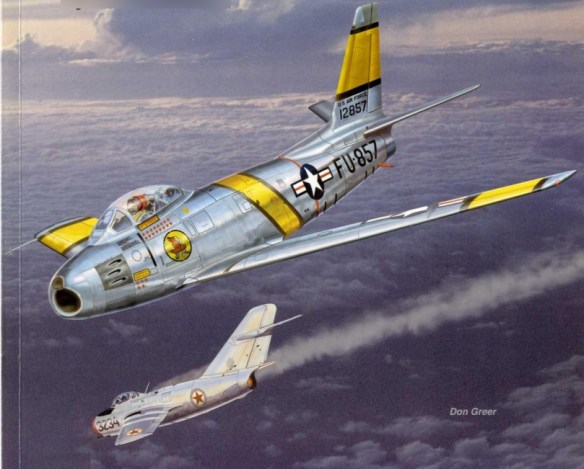The appearance of the MiG-15 jet fighter in November 1950 threatened UN air superiority over Korea because the MiG outperformed available U. S. aircraft. FEAF requested the newest and best jet fighters, and on December 6, less than a month later, the 27th Fighter-Escort Wing, flying F-84 Thunderjets, arrived at Taegu. Then, on December 15 the 4th Fighter-Interceptor Wing flew its first mission in Korea in F-86 Sabres. Less than a week later, on the 22d, F-86 pilots shot down six MiG-15s, losing only one Sabre. The newer jet fighters permitted the UNC to maintain air superiority.
Taking the offensive on January 25, 1951, the UNC began military operations directed toward wearing down the enemy rather than capturing territory. For two weeks UN forces, with close air support provided by Fifth Air Force fighter- bombers, advanced slowly northward against inconsistent but often stubborn resistance. On February 10 the troops captured Kimpo AB near Seoul. When thawing roads made ground transport virtually impossible, Brig. Gen. John P. Henebry’s 315th Air Division airdropped supplies to the ground forces. For example, between February 23 and 28 the 314th Troop Carrier Group, flying C-119s, dropped 1,358 tons of supplies to troops north of Wonju, a town 50 miles southeast of Seoul. UN forces reoccupied Seoul on March 14.
A few days later, on March 23, FEAF airdropped a reinforced regiment at Munsan, 25 miles north of Seoul. In preparation, fighter-bombers and medium bombers, under direction of airborne tactical controllers, bombed enemy troops and positions near the drop zones. The C-119s continued the airdrop of supplies until March 27, as the paratroopers advanced from Munsan to Yonchon, 35 miles north of Seoul.
By this time, Communist forces had established such a strong air presence between the Chongchon and Yalu Rivers in northwestern Korea that Fifth Air Force pilots began to refer to this region as “MiG Alley.” The Fifth, unable to challenge the enemy’s temporary air superiority in northwestern Korea from bases in Japan, returned its tactical fighter units to Korean airfields recently wrested from Communist control. By March 10, F-86 Sabres were once again battling Chinese and North Korean pilots in MiG Alley while flying cover for FEAF Bomber Command’s B-29s against targets in the area. Through the rest of March and April, FEAF bombed bridges over the Yalu River and other targets under the protection of escorting jet fighters. In spite of the escorts, MiG pilots on April 12 destroyed 3 of 38 B-29s attacking bridges at Sinuiju, causing the FEAF Bomber Command to put Sinuiju temporarily off-limits to B-29s.
During the CCF Spring Offensive, FEAF and the U. S. Navy maintained air superiority over Korea through aerial combat and continued bombing of North Korean airfields. The Fifth Air Force and a Marine Corps air wing extended airfield attacks on May 9 to include Sinuiju airfield in the northwest comer of Korea. MiG fighters from Antung airfield just across the Yalu River in Manchuria offered little resistance to the American raid. Jet fighter-bombers destroyed antiaircraft positions, followed by Marine Corsairs and Air Force Mustangs that bombed and rocketed targets around Sinuiju airfield. F-86s protected the attack aircraft from MiGs. This mission destroyed all North Korean aircraft on the field, most buildings, and several fuel, supply, and ammunition dumps. All U. S. aircraft returned safely from the Sinuiju raid.
Through most of May the Chinese pilots stayed on the Manchurian side of the Yalu River, but on the 20th 50 MiGs engaged 36 Sabres in aerial combat. During this fight Capt. James Jabara destroyed two MiGs. Added to his four previous victories, these credits made him the first jet ace in aviation history. MiG pilots again challenged Sabre flights escorting B-29 bombers on May 31 and June 1, but the Communists lost six more aircraft.
USAF officials recognized the need for more F-86s to counter the Chinese Air Force in Korea. The 51st Fighter-Interceptor Wing at Suwon AB, 15 miles south of Seoul, consequently received F-86s from the United States to replace its F-80s. On December 1, 1951, the wing flew its first combat missions in the new Sabres. Members of the 51st and 4th Fighter-Interceptor Wings shattered the Communists’ air offensive, downing 26 MiGs in two weeks, while losing only six F-86s. The Sabres achieved in the air results that had eluded the B-29s when they bombed the enemy airfields near Pyongyang. For the rest of the winter, the MiG pilots generally avoided aerial combat; nevertheless, Fifth Air Force pilots between January and April 1952 destroyed 127 Communist aircraft while losing only nine in aerial combat.
During the summer of 1952, the 4th and 51st Fighter-Interceptor Wings replaced many of their F-86Es with modified F-86Fs. The new Sabre aircraft had more powerful engines and improved leading wing-edges which allowed them to match the aerial combat performance of the MiG-15 jet fighters of the North Korean and Chinese air forces. Even though the Communists had built up their air order of battle, they still tended to restrict their flights to MiG Alley and often avoided aerial combat with the F-86 pilots. By August and September, however, MiG pilots showed more initiative, and aerial engagements occurred almost daily. Even though the Communist pilots improved their tactics and proficiency, U. S. pilots destroyed many more MiGs, achieving at the end of October a ratio of eight enemy losses to every U. S. loss.
